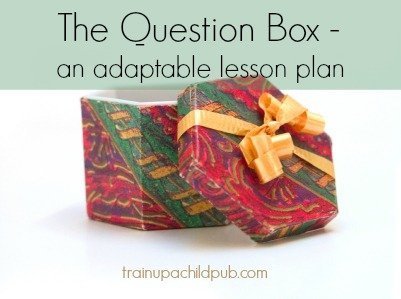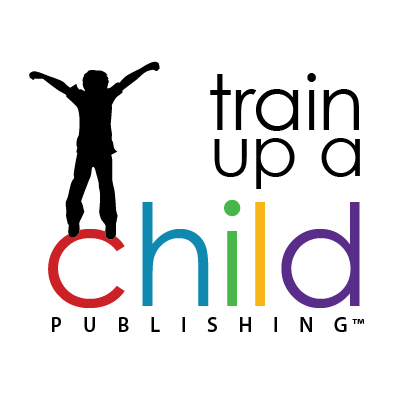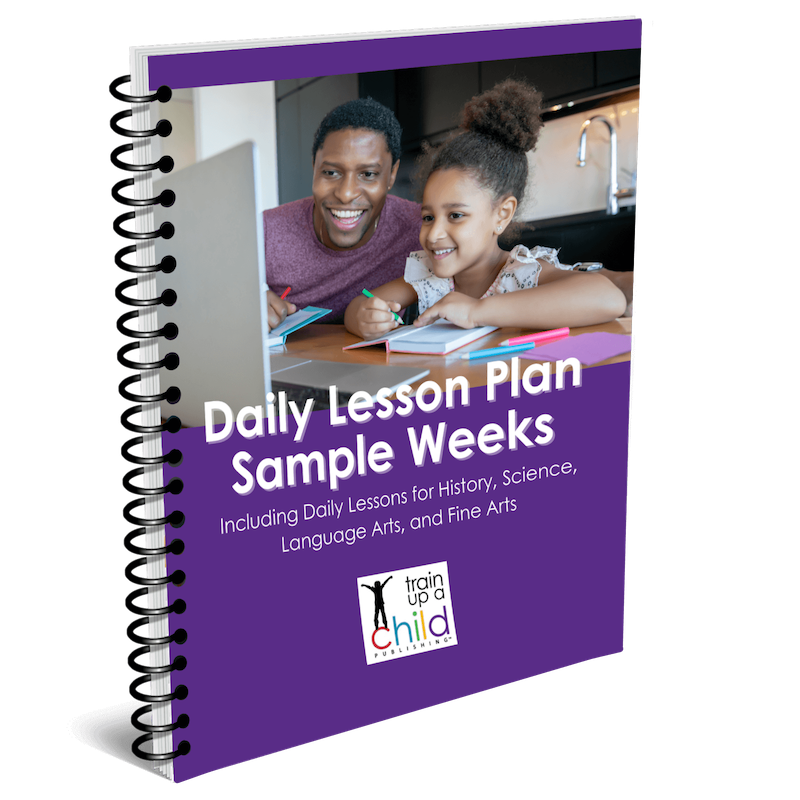The Question Box – an adaptable lesson plan for any subject!

The Question Box – an Adaptable Lesson Plan
I am not sure where it came from or where it went, to be honest, but we used to have a small, shoebox-sized hexagonal box. It had large red and green paisleys running around the outside. At one time, it probably held a yummy Christmas gift. We called it “The Question Box.” It was the best little “intro” to our daily study that warmed up the kids to what we were learning.
As you might know, we study history chronologically. We used our Question Box before we started history as a fun, hands-on way to kick off our history lesson for the day. However, it’s an adaptable idea you can use as a “warm-up” for almost any subject.
Using it made our history units so much fun by:
- beginning our history study with a fun, hands-on, challenging, “game-like” activity
- getting my kids excited about what they were going to be learning
- helping our kids actually see how much they were learning as the our history unit progressed
I’d say that was a win!
After morning devotions, our routine was to head upstairs to our “frog” (finished room over the garage) and start our academic day with the kids taking their turns excitedly pulling a question pertaining to our history study from the box.
Here’s how it worked.
How to use the Question Box for Middle Ages History
Customarily, I would make up numbered history and science fill-in-the blank and short answer questions on the computer and print them out, making the questions one color and the answers a different color.
I also made myself an answer key on a separate sheet of paper.
So you can cut the questions apart (and the answers from the questions) and put them into your question box. I suggest coding them so you know which are the ‘younger student’ questions and which are the ‘older.’
We would have a new boxful of history and science questions at the beginning of every history unit, and my kids always looked forward to a big box full of new questions!
Typically, at the start of a new unit they wouldn’t know many of the answers. (If they didn’t know the answer, the question went back into the box.)
But they had fun guessing and, at the same time, became more interested in what they would be learning. As we progressed through the unit, our kids got more and more of the questions right, and so I had to throw in some harder questions near the end of the unit just to keep things interesting.
By the end of the unit period they usually were able to answer all of the questions, even the hard ones. We also had contests and sometimes received prizes (like a piece of gum or an M&M) for answering, for example, three questions in a row correctly.
Ways to expand using the Question Box idea for other subjects:
- The kids could create and decorate the box. (Any subject.)
- Older students could make up questions for the younger ones. (Any subject.)
- Kids could pull a ‘seat work’ assignment out of the box, such as a verse to copy or memorize, a sentence with errors to edit, a short word problem to figure out, etc. (Bible, Language Arts, Math)
- An older elementary, middle, or high school student could pull out a person, place or event to research, write about, and present to the group (or to you) (History, Science, Fine Arts)
- You could use it to study countries, capitals and/or continents (they pick a country out of the box and have to say the capital and/or continent where it’s located) (Geography)
- You could use it to learn different landforms, bodies of water, mountain ranges (they choose a term they have to define or identify where it is located) (Geography)
- Use it to teach the definition of terms or systems (“Explain the water cycle,” or “Name 5 characteristics of mammals/living things/insects”) (Science)
- Use the question box for definitions and/or examples of literary terms (“Explain the term ‘setting’ and how it was used in Wuthering Heights”) (Language Arts)
- Have your children pick different exercises to do out of the question box. (Physical Education)
Even household chores for that day could be chosen from a box!
As I have been slowly cleaning my way through the school room recently, I came across some of our Middle Ages questions that would be appropriate for late Primary, Intermediate or early Preparatory students. The last five or so would be suitable for Preparatory and/or Secondary students.
Sample Middle Ages Questions and Answers
The answers are in bold type and in parentheses after the questions:
- What is the name of the part of a castle that is a tower, often round, with many stories? There, nobles slept, ate and planned. Soldiers lived on lower stories with the dungeon below. (keep)
- Between 1100 and 1300 AD, large groups of knights, nobles and even some peasants (and children!) traveled from Europe to the Middle East to try and take possession of the Holy Lands from the Turks. These trips were called the ___________. (Crusades)
- What are two popular games played today that originated during the Middle Ages? (chess and checkers)
- During the Middle Ages, craft _________ were set up to make sure their members were properly trained as apprentices and produced high quality goods. (guilds)
- From what disease in the 1300’s did about a third of all the people in Europe die? (the Black Death or Bubonic Plague)
- What was the name of a legendary king who ruled a Kingdom where people were peaceful and content? He came to represent the ideals of justice, peace and honor. (King Arthur)
- Large, rural estates were called _________. (manors)
- A craftsman who made tools, weapons, and cooking utensils from iron was called a _______. (blacksmith)
- Books were copied by hand, one by one, usually by ___________. (monks)
- In manor houses, people used ____and _______ to cover walls, to keep out drafts, and/or to divide rooms. (carpets and tapestries)
- What were musicians called who traveled around the country, played, sang, and told stories at special feasts and other events? (minstrels)
- ________ traveled great distances to buy and sell goods. (Traders or merchants)
- A special design each knight carried on a shield or his clothing that helped knights tell each other apart in battle was called a _____ __ ____. (coat of arms)
- What were pictures called that were painted directly onto wet plaster? (frescoes)
- What was a mechanical device called that hurled heavy objects into the air, at or over castle walls during an attack? (a catapult)
- The ________ ________ was a survey completed in 1086 of nearly all the lands in England and was conducted by officials of King William the First (also known as William the Conqueror). (the Domesday Book)
- Dried plant seeds, roots, and/or leaves that were used to flavor foods or make not-so-fresh meat taste better (and were quiet expensive) were called ________. (spices)
- The _________ was one of the most highly skilled craftsman of the middle ages, combining the jobs of architect, builder, engineer, and sculptor today, working on all stages of a building project. (mason)
- Many ________ and _________ were used as medieval remedies for sickness and disease. (plants and herbs)
- What was depicted by the famous Bayeux Tapestry? (The Bayeux Tapestry depicts the famous Battle of Hastings in 1066, when the Norman invader William, Duke of Normandy, challenged Saxon King Harold.William’s forces won the battle; henceforth, he was called William the Conqueror.)
- Briefly describe the feudal system. (The King owned everything. Under him were the Lords and Ladies, who controlled their own territories. They had knights for protection of their land and also could be called upon by the king. Vassals gave loyalty, service, and a portion of their crops to lords in exchange for the use of the Lord’s land and for military protection.)
- Describe the concept of chivalry. (Chivalry is a group of character qualities thought to be exhibited by the perfect knight, including loyalty, honesty, courage, and courteousness—especially towards women.)
- Describe the Magna Carta and its significance, as well as the circumstances under which it was signed. (The “Great Charter” was the first document in English history that forced a monarch to be subject to the law and provided for the creation of a strong parliament. King John, a wicked and greedy king who had levied incredibly high taxes, was forced to sign it by his rebellious barons in 1215 in Runnymede, England.Once it was signed, the barons again swore fealty to King John, not realizing the king had no intention of keeping the agreement.)
- Name at least one key character from the Middle Ages and describe why he or she was historically significant. This has many possible answers! Among them:
- Alfred the Great: a noble and wise ruler who bought about an educational revival in England;
- King John: [see question #23 above]
- Joan of Arc: a young French girl who rallied the French against the English and who victoriously led the French army in battle.She was eventually captured and burned at the stake as a witch
- Charlemagne: French ruler, Charles the Great, who controlled most of west and central Europe and presided over what was called the Carolingian Renaissance
- Genghis and Kublai Khan: Grandfather and Grandson, these Mongolian leaders ruled over much of Asia and nearly part of Europe. Although Buddhist, they were tolerant of most religions other than Islam. Kublai did much to encourage literature and the arts.)
- Who were the Moors? (A nomadic people from Northern Africa, the Moors descended from Arabs and Berbers who had moved into the Holy Lands and spent many years fighting the English during the Crusades. They are known for their goal to spread Islam across the world and for their magnificent, unusual architecture.)
Please feel free to use these questions in your homeschool, and have fun making up some of your own!
If you would like to have these Middle Ages questions and answers in a printable format for your question box, use the contact form in the top menu to let us know!
Have fun with your Question Box!
![]()


I like the mystery behind an idea like this. Thanks for sharing.
Hi, Sherri. Yes, that sense of the “unknown” always is appealing! Thanks for reading and taking a minute to share your thoughts. 🙂
We also have a similar box. We call it our “PE” box. It is full of multicolored slips of paper, each having a physical activity or sports question which would need to be researched to answer. This way my daughter can simply pick a slip and know what to do for her gym class. We do races, exercises, physical activities and challenges such as carrying a ball on her head while walking 5 feet (no hands), jump rope for 30 times without a miss, tree climbing, balancing on a 2×4 on the ground and walking quickly from one end to the other, running backwards, or maybe researching the rules for volleyball which she then may narrate to me (using the chalkboard if applicable).
Good morning, Evelyn~what great ideas! I love the idea of using the box idea for PE! It’s amazing how much more fun it is for our kids when we present activities with a little creativity like that. Thanks so much for sharing how you use this concept at your house! Thanks for visiting and for taking the time to share! 🙂
I LOVE this idea! 🙂
We really had fun with it, Shelly. The kids loved it!
Pro Tip! For all of you Unit Study Program curriculum users: Use the Overviews of each time period included in each unit to help you make up history questions! Have fun! Dana